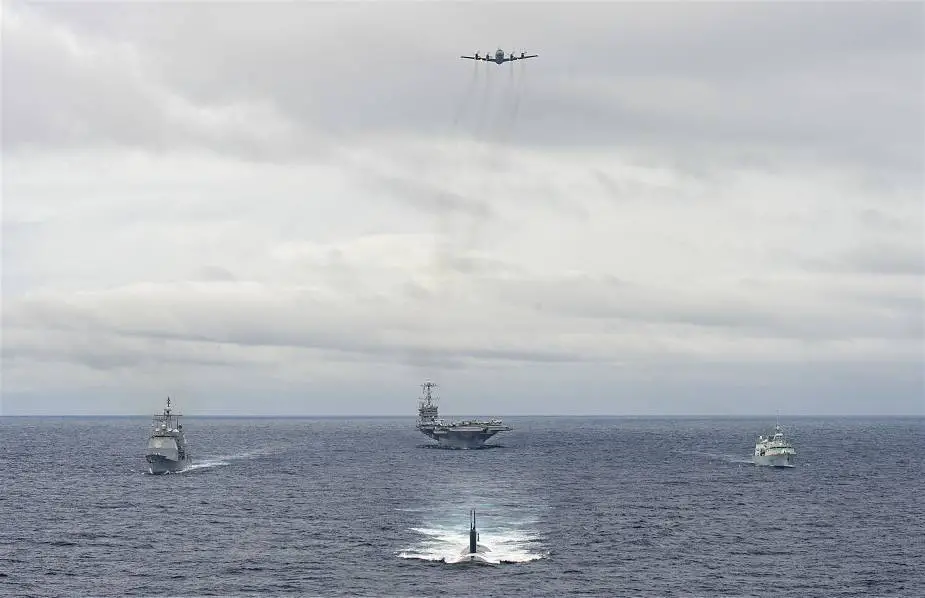Breaking news
US Naval Forces Northern Command completes Vigilant Osprey homeland defense exercise.
U.S. Naval Forces Northern Command (NAVNORTH) units completed U.S. Northern Command-led exercise Vigilant Osprey, a major service-integrated homeland defense exercise aimed to strengthen operational partnerships with allied nations, May 31, 2020. Information released by the U.S. Navy on June 2, 2020.
Follow Navy Recognition on Google News at this link
 The Royal Canadian Navy Halifax-class frigate HMCS Ville de Quebec (FFH 332), right, the Los Angeles-class fast-attack submarine USS Montpelier (SSN 765), the Nimitz-class aircraft carrier USS Harry S. Truman (CVN 75) and the Ticonderoga-class guided-missile cruiser USS Normandy (CG 60) transit in formation with a Royal Canadian Air Force CP-140 Aurora during a photographic exercise in the North Atlantic Ocean, May 31, 2020. (Picture source U.S. Navy)
The Royal Canadian Navy Halifax-class frigate HMCS Ville de Quebec (FFH 332), right, the Los Angeles-class fast-attack submarine USS Montpelier (SSN 765), the Nimitz-class aircraft carrier USS Harry S. Truman (CVN 75) and the Ticonderoga-class guided-missile cruiser USS Normandy (CG 60) transit in formation with a Royal Canadian Air Force CP-140 Aurora during a photographic exercise in the North Atlantic Ocean, May 31, 2020. (Picture source U.S. Navy)
The Harry S. Truman Carrier Strike Group (HSTCSG), as well as Atlantic-based Navy submarines and aircraft, alongside forces from Canada, Denmark, and the U.S. Air Force were able to learn from the other services and combatant commanders while advancing tactical and operational proficiency in high-end warfare.
Elements of the Royal Canadian Navy (RCN) and Royal Canadian Air Force (RCAF) joined with HSTCSG to conduct a bi-national, multi-domain exercise in the Atlantic Ocean. The RCN provided afloat logistics support to the CSG, HMCS Ville de Quebec (VDQ) participated in bi-lateral anti-submarine warfare (ASW) and air defense exercise with HSTCSG, while CP-140 Aurora Long-Range Patrol aircraft conducted multiple overflights and participated in ASW events.
Commander, U.S 2nd Fleet (C2F), as NAVNORTH’s Maritime Command Element-East (MCE-E), and Joint Arctic Command (JACO) HQ in Nuuk, Greenland exercised tactical and operational information sharing in order to improve mutual situational awareness. The exercise between these headquarters ensured both classified and unclassified information could be shared in real-time.
While operating alongside supporting assets from the Northern American Aerospace Defense Command (NORAD), U.S. Transportation Command (TRANSCOM), U.S. Strategic Command (STRATCOM), and the newly formed U.S. Space Command (SPACECOM), the strike group demonstrated their role in the National Defense Strategy as a flexible and lethal asset ready to defend the homeland.
The naming for exercise Vigilant Osprey is in homage to the people and geographic location in which it was conducted. Vigilant is typically used in NORTHCOM exercises, and Osprey, Nova Scotia’s provincial bird, is a tribute to the Canadian participants. The naming of the exercise is to honor the victims of the mass shooting which occurred in Nova Scotia several weeks ago, the loss of six aircrew and sailors in a military helicopter crash, and to Capt. Jennifer Casey, the Canadian Forces Snowbird’s Public Affairs Officer who was killed in a jet crash this month.
The HSTCSG is comprised of the flagship aircraft carrier USS Harry S. Truman (CVN 75) and the embarked squadrons of Carrier Air Wing 1, Destroyer Squadron 28, Ticonderoga-class guided-missile cruiser USS Normandy (CG 60), and Arleigh Burke-class guided-missile destroyers USS Lassen (DDG 82), USS Forrest Sherman (DDG 98), and USS Farragut (DDG 99).
The strike group recently operated under the command of U.S. 5th and 6th Fleets, and the deployment serves as another example of how our Naval forces continue to be the most inherently flexible & available assets in times of crisis, providing presence & capabilities when needed. HSTCSG remains at sea in the Atlantic, conducting operations and is ready for tasking, while protecting the crew from the risks posed by the COVID-19 pandemic.


























